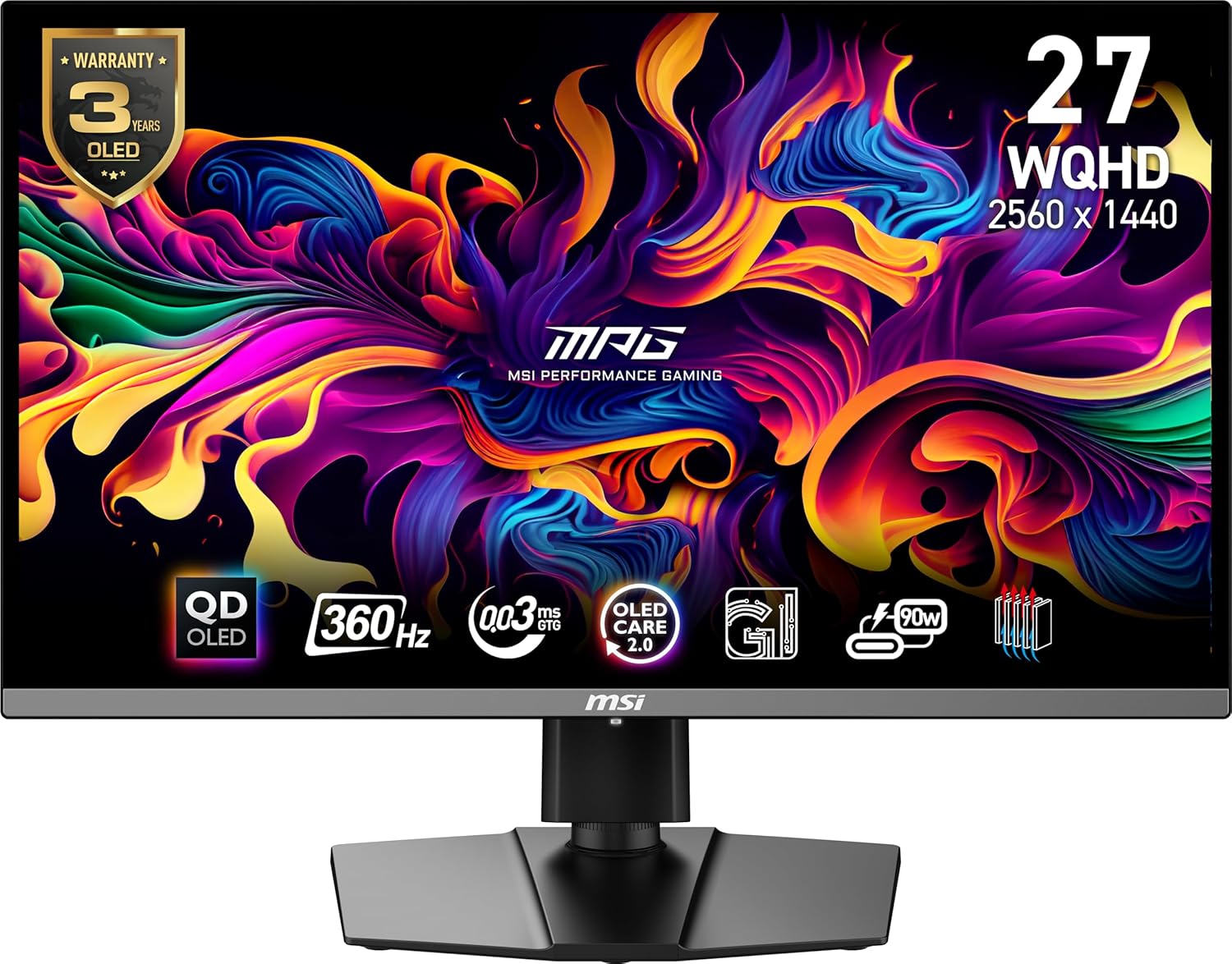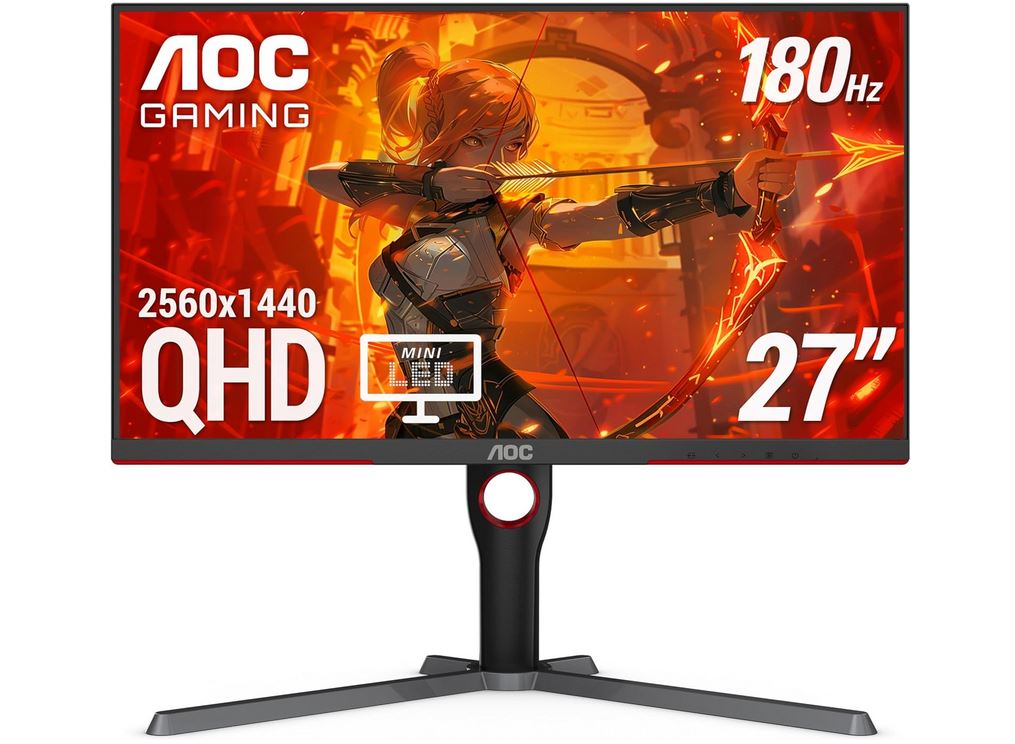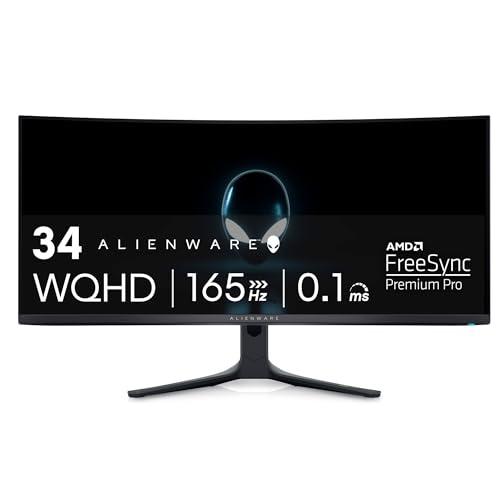Best 1440p monitors 2025: our top picks for QHD gaming

Table of Contents
As CPU and GPU tech in PCs has become more advanced, 1440p monitors have pretty much become the new standard for a lot of people, indeed it's a screen of this type that currently has the top spot in our main best gaming monitor guide. At one time running games at this resolution for good FPS would have required hardware beyond the reach of the average consumer, but now, unless you're a hardcore competitive gamer, the greater crispness and detail this higher resolution brings, particularly on medium-to-larger screen sizes, makes many a 1080p monitor now look a bit outdated. The greater resolution has advantages for creatives as well.
This guide will cover 1440p monitors in the standard 16:9 aspect ratio, with resolutions of 2560×1440, as well as ultrawide monitors with the 21:9 aspect ratio with resolutions of 3440×1440. We'll be looking at models with a range of different screen sizes, budgets, and panel types (including OLED monitors, Mini LED monitors, and the more old-school VA and IPS panels), flatscreen and curved, so as to give a variety of options – one of them is bound to meet your needs!
Prime Day may have closed its doors, but that hasn't stopped great deals from landing on the web's biggest online retailer. Here are all the best last chance savings from this year's Prime event.
- Sapphire Pulse AMD Radeon™ RX 9070 XT Was $779 Now $719
- AMD Ryzen 7 7800X3D Processor Was $449 Now $341
- Skytech King 95 Ryzen 7 9800X3D gaming PC Was $2,899 Now $2,599
- LG 77-Inch Class OLED C5 TV Was $3,696 Now $2,996
- AOC Laptop Computer 16GB RAM 512GB SSD Was $360.99 Now $306.84
- Lexar 2TB NM1090 w/HeatSink SSD Was $281.97 Now $214.98
- Apple Watch Series 10 GPS+ Smartwatch Was $499.99 Now $379.99
- AMD Ryzen 9 5950X processor Was $3199.99 Now $279.99
- Garmin vívoactive 5 Smartwatch Was $299.99 Now $190
*Prices and savings subject to change. Click through to get the current prices.
Products at a glance
-
MSI MPG QD-OLED 27″ Gaming Monitor (271QRX)
- Panel type: QD-OLED panel
- Resolution: 2560 x 1440
- Refresh rate: 360Hz
- Response time: 0.03ms
- Panel size: 27″
-
Sony INZONE M10S (27″, OLED)
- Panel type: WOLED
- Resolution: 2560 x 1440
- Refresh rate: 480Hz
- Response time: 0.03ms
- Panel size: 27″
- I/O ports: 1x DisplayPort 2.1, 2x HDMI 2.1, 2x USB-A, 1x USB-B, 1x 3.5mm audio jack
-
AOC Q27G3XMN 27″ Gaming Monitor
- Panel type: VA (with Mini-LED backlighting)
- Resolution: 2560 x 1440
- Refresh rate: 180Hz
- Response time: 1ms
- Panel size: 27″
-
Xiaomi G Pro 27i Gaming Monitor (QHD)
- Panel type: IPS (with Mini-LED backlighting)
- Resolution: 2560 x 1440
- Refresh rate: 180Hz
- Response time: 1ms
- Panel size: 27″
-
Alienware AW3423DWF Curved QD-OLED Gaming Monitor (34″)
- Panel type: QD-OLED
- Resolution: 3440 x 1440
- Refresh rate: 165Hz
- Panel size: 34.18″
- Response Time: 0.1ms
Why should you buy a 1440p monitor?
If you've got a reasonably powerful PC, 1440p is the ideal resolution to enjoy crisp visuals and immersion in your games whilst not being as draining on performance as running a 4K monitor would be. You can now get 1440p monitors with very high refresh rates – all the way up to 480Hz, as well as all the same benefits of VRR (including G-Sync and FreeSync) and fast-response times that 1080p monitors can have. The greater resolution means you can use a bigger-sized screen without the images (or text) on it appearing pixellated, unlocking extra screen space for multiple windows, should you decide to go for a larger model. That being said, there's still definitely a place for 1080p monitors with smaller screens, which will still look sharp, particularly if your focus is on squeezing out maximum FPS, or you're running an older/less powerful rig.
Best 1440p monitors: our top picks

- Panel type: QD-OLED panel
- Resolution: 2560 x 1440
- Refresh rate: 360Hz
- Response time: 0.03ms
- Panel size: 27″
- 360Hz with excellent response time
- OLED panel has a fantastic contrast ratio
- 99% DCI-P3 coverage & high color accuracy
- Great HDR performance
- KVM switch, USB hub & 90W USB-C power delivery
- HDMI 2.1
- Lower pixel density impacts text legibility
- Not very bright in SDR mode
- Not the cheapest
If you don't mind spending a bit of cash, the MPG 271QRX from MSI is our best overall 1400p monitor for gaming. This QD-OLED screen is tailored specifically for competitive players who prioritize speed and precision. It comes with a very fast 360Hz refresh rate paired with an ultra-fast 0.03ms gray-to-gray response time, delivering an incredibly smooth and responsive experience that surpasses even many of its OLED rivals that are generally known for quick response times. Being an HDMI 2.1 monitor, it's also well-suited for next-gen console use (though these will be limited to 240Hz, that's a limitation of the consoles, rather than the screen).
This display also shines in color performance, offering near-complete coverage of the DCI-P3 spectrum (99%) and full sRGB (100%) compliance, with high color accuracy that makes it a solid pick for creative professionals. As an OLED screen it also has unbeatable contrast ratio, and perfect blacks, making it also excellent for viewing HDR content. The glossy screen really makes those colors and highlights pop when gaming too.
As is typical with many OLED screens, the MPG 271QRX does fall a bit short when it comes to rendering razor-sharp text, and its peak brightness in full-screen SDR mode sits around 254 nits – not exactly ideal for brightly lit workspaces or long office sessions – plus the glossy screen does exacerbate this further.
If you can put up with this though, the monitor does include numerous features helping to improve its usefulness as a general productivity machine besides gaming, including a USB hub, an integrated KVM switch, and 90W USB-C power delivery, making it quite versatile.

- Panel type: WOLED
- Resolution: 2560 x 1440
- Refresh rate: 480Hz
- Response time: 0.03ms
- Panel size: 27″
- I/O ports: 1x DisplayPort 2.1, 2x HDMI 2.1, 2x USB-A, 1x USB-B, 1x 3.5mm audio jack
- The fastest refresh rate in the game & excellent response time
- OLED panel has a fantastic contrast ratio
- 100% sRGB coverage & high color accuracy
- Expensive
- Not the brightest
- 480Hz refresh rate is unnecessary for most consumers
The Sony INZONE M10S has the fastest maximum refresh rate available to a 1440p monitor: a frankly preposterous 480Hz. There aren't many people for whom such a refresh rate will be particularly useful, never mind necessary, but if you are a serious competitive player with the hardware to push your favourite games to near 480FPS, then this is an excellent pick. As an OLED monitor, it also benefits from near-instantaneous response times.
This premium 27-inch gaming monitor also comes with additional features to enhance your esports experience, such as a specialized FPS Pro+ mode developed in collaboration with Fnatic themselves, which enhances visual clarity by making enemy targets more visible. There's also a unique option to scale the display down to a 24.5-inch virtual screen size, catering to the preferences of professional players. As you'd expect it supports the full range of variable refresh rate technologies, including G-Sync and FreeSync. The monitor also comes with its own heatsink, plus the latest OLED care features to prevent-burn-in.
Overall image quality is excellent: with perfect blacks, high contrast, and full coverage of the sRGB color space. Its color accuracy also makes it a viable choice for color-sensitive tasks, should you want to utilize it for creative work. That said, brightness remains one of its weaker areas as with other OLED screens. Despite featuring Micro Lens Array+ (MLA+) technology, full-screen SDR brightness peaks around 245 nits, which may be underwhelming for users in bright environments. Besides this, the only other real drawback of this display is the rather steep price tag.

- Panel type: VA (with Mini-LED backlighting)
- Resolution: 2560 x 1440
- Refresh rate: 180Hz
- Response time: 1ms
- Panel size: 27″
- Great contrast thanks to 336 dimming zones
- Great value for money
- Good brightness thanks to Mini-LED backlighting
- 99% sRGB coverage & high color accuracy
- Some black smearing in fast-moving scenes
- Suffers from a slight red tint on some presets
- No HDMI 2.1 support
Crowned as the best gaming monitor of the year in our 2024 awards, the AOC Q27G3XMN stands out for delivering impressive performance at a very competitive price point. While it isn't flawless, it hits the sweet spot for everyday gamers seeking solid image quality, good brightness levels, and a high refresh rate, all for a reasonable price. The monitor features a standard 27-inch display with a 16:9 aspect ratio and a crisp 2560×1440 resolution. It supports a 180Hz refresh rate, which, while not the highest available, should satisfy most gamers. Response times are generally snappy, helping to reduce ghosting.
One of the more distinctive aspects of this display is its use of a VA panel paired with advanced Mini-LED backlighting, featuring 336 local dimming zones. The backlighting enables the screen to hit a peak brightness of around 630 nits without dimming enabled, and still maintains a solid 410 nits with dimming active – making it well-suited to bright rooms like offices. The local dimming also helps create deeper blacks and excellent contrast for darker environments, plus enhances its HDR capabilities. As a result of this, the Q27G3XMN comes with VESA DisplayHDR 1000 certification.
With 99% coverage of the sRGB color gamut and good out-of-the-box accuracy, the screen is also viable for color-based content creation, including photo editing. It should be stated that a lot of the presets have a tone that appears overly red to the naked eye, which is less than ideal, although if you tinker about in the settings you can get rid of this fairly easily.
The main downside of this screen is that users may notice occasional black smearing during fast-paced scenes, a common issue with VA panels. How much this will bother you depends on how easily you notice such things. Besides this there are a few other minor trade-offs: limited viewing angles, no support for HDMI 2.1, and a fairly plain design that may not stand out on your desk, however, all these are pretty acceptable given the price point.

- Panel type: IPS (with Mini-LED backlighting)
- Resolution: 2560 x 1440
- Refresh rate: 180Hz
- Response time: 1ms
- Panel size: 27″
- Great value for money
- Fantastically high peak SDR brightness
- 99% sRGB/ 99% DCI-P3 coverage & high color accuracy
- Weak contrast unless local dimming is enabled
- No HDMI 2.1 support
- No USB-C ports
The Xiaomi G Pro 27i is another 27-inch 1440p monitor that offers fantastic value for money, and also comes with Mini-LED backlighting (this time with an IPS panel), meaning excellent peak brightness. In fact the full-screen SDR brightness of around 890cd/m² is the highest of any model on this page, so is excellent for brightly lit environments. Color replication and accuracy are also very good in both the sRGB and DCI-P3 spaces, meaning you could definitely use it for color-based workflows in these spaces, however, the contrast ratio is quite weak on this display unfortunately, which may turn some people off. Enabling local dimming does help with this somewhat though.
The 180Hz refresh rate is again solid for gaming and the response time is solid, though it doesn't match up to the OLED displays on this list. As with our other value pick you don't get HDMI 2.1 support, so console gamers will probably wish to look elsewhere. The monitor also lacks any USB-C sockets.

- Panel type: QD-OLED
- Resolution: 3440 x 1440
- Refresh rate: 165Hz
- Panel size: 34.18″
- Response Time: 0.1ms
- Immersive ultrawide screen
- Excellent response time
- OLED panel has fantastic contrast ratio
- 99% sRGB coverage & high color accuracy
- Good value for money
- Looks great
- Lower pixel density impacts text legibility
- Not very bright
- 165Hz refresh rate might turn-off competitive gamers
The top pick for our ultrawide 1440p monitor is the Alienware 34 QD-OLED AW3423DWF. It's not the most premium ultrawide monitor out there in this resolution, however it offers an exceptional balance between price and performance, making it our top recommendation for value-conscious gamers.
This monitor maintains the top-notch aesthetics and build quality of other Alienware products, whilst being surprisingly affordable. It sports a 34-inch curved screen with a 1800R radius, offering an immersive viewing experience ideal for gaming and media. The 165Hz refresh rate, while not the highest around, should be more than adequate for the vast majority of players. And thanks to the OLED panel's nearly instantaneous response times, motion stays crisp and blur is kept to a minimum.
As with many OLED monitors, the screen has a glossy finish, which enhances contrast and gives colors an extra pop – perfect for HDR content and vibrant games. On the downside, that reflectivity can be a drawback in rooms with a lot of ambient light. Peak SDR brightness reaches around 240 nits, which is fairly typical for OLED technology but underwhelming by broader monitor standards. Thankfully, the built-in Automatic Brightness Limiter (ABL) is relatively subtle here, avoiding the harsh dips in luminance that plague some competing models during extended sessions. For general productivity, the 3440×1440 resolution stretched across a screen this size does affect text legibility somewhat, but for gaming or watching video media it is fantastic.
How do we choose the best 1440p monitors?
To identify the top-performing 1440p monitors, we follow a thorough evaluation process that blends hands-on testing, technical analysis, and feedback from users. Whenever possible, we personally test and benchmark each monitor to provide accurate, firsthand insights. In cases where direct testing isn't feasible, we rely exclusively on reliable, well-established sources for performance data.
Our assessment considers key criteria including native resolution, refresh rate, physical adjustability, port availability, user controls, and bonus features such as HDR capabilities or adaptive sync technologies like AMD FreeSync and NVIDIA G-Sync.
For performance benchmarking, we use DisplaCAL software alongside the X-Rite i1Display Pro calibration tool to examine essential image quality metrics. This includes testing for color accuracy, brightness levels, contrast ratio, gamma performance, white and black balance, and overall panel consistency. These tests help us determine whether a monitor is better suited for everyday use, competitive gaming, or professional content creation – depending on its intended audience.
1440p monitor FAQ
If you're looking to brush up on your 1440p monitor knowledge, have a read below at some of the most commonly asked questions.
Are QHD and 2K the same as 1440p?
In a word: yes. QHD, 2K, and 1440p are all different ways of describing the same monitor resolution, specifically 2560×1440. Lower down the resolution scale is the 1920×1080/FHD/1080p monitor, and higher up we have the 3840×2160/UHD/4K monitor.
What is QHD+?
QHD+ is another way to describe 1600p resolution monitors. 1600p refers to the 1,600 vertical pixels on a 2560×1600 monitor, which have the same horizontal pixel count as 1440p monitors, but just a bit more vertical space, and adhere to the 16:10 aspect ratio, rather than 16:9.
QHD+ monitors are generally considered a bit better for reading documents and web pages, as you can see a bit more on the screen at any one time. Some people prefer 16:9 however, as they do not like the black bars which you get when viewing 16:9 content (the common aspect ratio for the content of most streaming services and YouTube) on a 16:10 screen.
Are 1440p monitors expensive?
1440p monitors range in price depending upon the panel type, refresh rate, included features, and overall quality of the screen. Although they are still more expensive than 1080p monitors, you can now pick up some 1440p/QHD displays at relatively accessible prices, compared to what they cost a few years ago.

